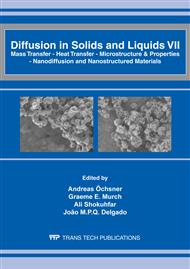p.99
p.105
p.111
p.115
p.120
p.126
p.132
p.141
p.147
Three-Dimensional Diffusion in Arbitrary Domain Using Generalized Coordinates for the Boundary Condition of the First Kind: Application in Drying
Abstract:
This work presents a three-dimensional numerical solution for the diffusion equation in transient state, in an arbitrary domain. For this end, the diffusion equation was discretized using the finite volume method with a fully implicit formulation and generalized coordinates, for the equilibrium boundary condition. For each time step, the system of equations obtained for a given structured mesh was solved by the Gauss-Seidel method. The computational code was developed in FORTRAN, using the CFV 6.6.0 Studio, in a Windows platform. The proposed solution was validated using analytical and numerical solutions of the diffusion equation for different geometries (orthogonal and non-orthogonal meshes). The analysis and comparison of the results showed that the proposed solution provides correct results for the cases investigated. The developed computational code was applied in the simulation of the drying of ceramic roof tiles for the following temperature: 55.6 °C. The analysis of the results makes it possible to affirm that the developed numerical solution satisfactorily describes the drying processes in this temperature.
Info:
Periodical:
Pages:
120-125
Citation:
Online since:
April 2012
Price:
Сopyright:
© 2012 Trans Tech Publications Ltd. All Rights Reserved
Share:
Citation:


